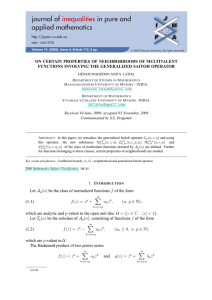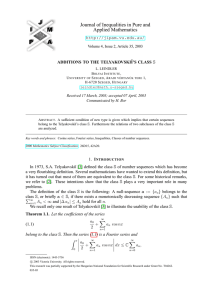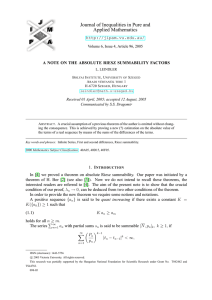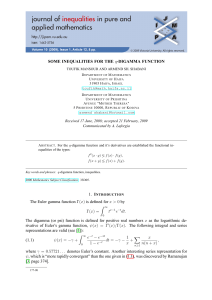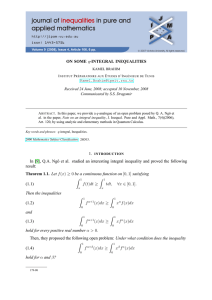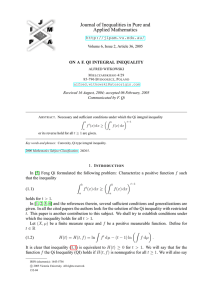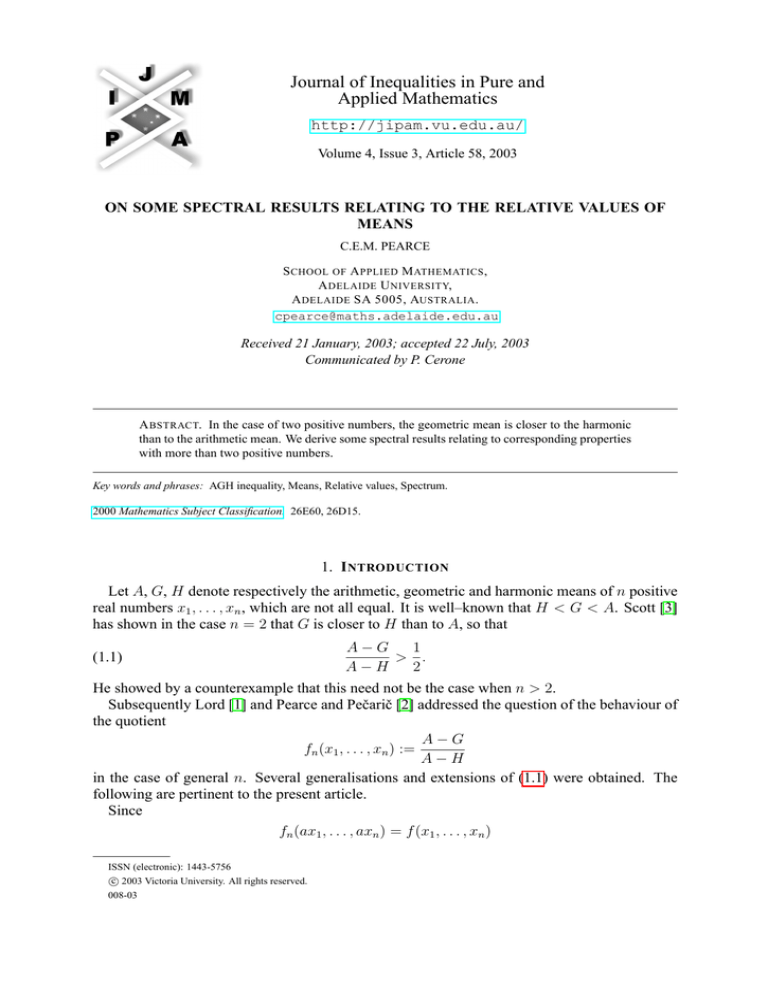
Journal of Inequalities in Pure and
Applied Mathematics
http://jipam.vu.edu.au/
Volume 4, Issue 3, Article 58, 2003
ON SOME SPECTRAL RESULTS RELATING TO THE RELATIVE VALUES OF
MEANS
C.E.M. PEARCE
S CHOOL OF A PPLIED M ATHEMATICS ,
A DELAIDE U NIVERSITY,
A DELAIDE SA 5005, AUSTRALIA .
cpearce@maths.adelaide.edu.au
Received 21 January, 2003; accepted 22 July, 2003
Communicated by P. Cerone
A BSTRACT. In the case of two positive numbers, the geometric mean is closer to the harmonic
than to the arithmetic mean. We derive some spectral results relating to corresponding properties
with more than two positive numbers.
Key words and phrases: AGH inequality, Means, Relative values, Spectrum.
2000 Mathematics Subject Classification. 26E60, 26D15.
1. I NTRODUCTION
Let A, G, H denote respectively the arithmetic, geometric and harmonic means of n positive
real numbers x1 , . . . , xn , which are not all equal. It is well–known that H < G < A. Scott [3]
has shown in the case n = 2 that G is closer to H than to A, so that
(1.1)
A−G
1
> .
A−H
2
He showed by a counterexample that this need not be the case when n > 2.
Subsequently Lord [1] and Pearce and Pečarič [2] addressed the question of the behaviour of
the quotient
A−G
fn (x1 , . . . , xn ) :=
A−H
in the case of general n. Several generalisations and extensions of (1.1) were obtained. The
following are pertinent to the present article.
Since
fn (ax1 , . . . , axn ) = f (x1 , . . . , xn )
ISSN (electronic): 1443-5756
c 2003 Victoria University. All rights reserved.
008-03
2
C.E.M. P EARCE
for a > 0, it suffices to consider the values taken by fn when x = (x1 , . . . , xn ) lies on the
intersection
)
(
n
X
K := x ∈ Rn : xi ≥ 0 for 1 ≤ i ≤ n and
x2i = 1
i=1
of the nonnegative orthant and the surface of the unit hypersphere. The function fn is clearly
well–defined and continuous on the interior of K except at e := √1n , . . . , √1n , where it is
undefined since A, G and H all coincide. In fact this singularity is removable. It is shown in
[1] that defining fn (x) = 1 for boundary points of K (where some but not all values xi vanish)
and fn (e) = 21 makes fn continuous on the whole of K. Since K is compact, fn possesses and
realises an infimum αn . Further, the range of fn constitutes the interval [αn , 1], the sequence
1
(αn )∞
2 is strictly decreasing to limit zero and αn > n for n ≥ 3. The seminal paper of Scott
1
gives α2 = 2 .
In this article we continue the development of [1] and [2] and derive some striking structural
results, principally as follows. In Section 2, Theorem 2.1, we show that if x is such that fn (x) =
αn , then {x1 , . . . , xn } contains precisely two distinct values. In Section 3, Theorem 3.3, we
show that if fn (x) = αn , then the smaller of the two distinct components of x must occur with
multiplicity one. We conclude in Section 4 by giving characterisations of αn and some related
infima arising naturally in our analysis.
We postpone consideration of asymptotics to a subsequent article.
2. T HE D ICHOTOMY T HEOREM
Theorem 2.1. For n > 2, any set {x1 , . . . , xn } for which fn (x) = αn contains precisely two
distinct values.
P
Q
Proof. First suppose that S1 := ni=1 xi and Sn := ni=1 P
xi are fixed. Subject to these constraints, the mimimum of fn correspond to an extremum of ni=1 x1i and satisfies
∂L
= 0 for i = 1, . . . , n,
∂xi
where L denotes the Lagrangian
n
n
X
X
1
L :=
−λ
x i − S1
x
i
i=1
i=1
Then
!
−µ
Y
∂L
1
=− 2 −λ−µ
xj = 0
∂xi
xi
j6=i
n
Y
!
x i − Sn .
i=1
(i = 1, . . . , n),
that is,
1
+ λxi + µSn = 0 (i = 1, . . . , n).
xi
Hence each xi must be equal to one of the two solutions of the quadratic
λx2 + µSn x + 1 = 0.
For a minimum, these solutions must be distinct, since fn (e) =
1
2
while αn <
1
2
for n ≥ 3.
For j = 1, 2, . . . , n and fixed n > 2, define
Vj = {x : {x1 , . . . , xn } contains precisely j distinct values} ,
Vj∗ = {fn (x) : x ∈ Vj }
J. Inequal. Pure and Appl. Math., 4(3) Art. 58, 2003
http://jipam.vu.edu.au/
S PECTRAL R ESULTS
3
and
δj = inf Vj∗ .
An immediate implication of Theorem 2.1 is the following result.
Corollary 2.2. We have
δ2 = δ3 = · · · = δn = αn .
For j > 1, the set Vj∗ contains its infimum only for j = 2.
Proof. If 1 ≤ j ≤ n − 1, any element of Vj can be approximated arbitrarily closely by elements
of Vj+1 , but not conversely. Since K is compact and fn continuous, we must therefore have that
δj+1 ≤ δj . Thus
1
δn ≤ δn−1 ≤ . . . ≤ δ2 ≤ δ1 = .
2
On the other hand, by Theorem 2.1
δ2 = αn = inf {fn (x)} = min{δ1 , δ2 , . . . , δn }.
The first part of the corollary follows.
The second part follows by invoking Theorem 2.1 again.
3. C OMPARISON R ESULTS
In the remaining sections of the paper we examine more closely the central case when
{x1 , . . . , xn } contains only two distinct values, that is x ∈ V2 . We may assume without loss of
generality an ordering
x1 ≤ x2 ≤ · · · ≤ xn .
We decompose
V2 =
n−1
[
Uk ,
k=1
where
Uk = {x : x1 = x2 = · · · = xk < xk+1 = · · · = xn }
(1 ≤ k < n).
For x ∈ Uk we have for the k equal points denoted by x and the rest by y that
k
k
x
+
1
−
y − xk/n y 1−k/n
A−G
n
n
.
.
=
k
k
n−k
k
A−H
x
+
1
−
y
−
n
+
n
n
x
y
If we set β = k/n and u = x/y, this gives
fn (x) =
βu + 1 − β − uβ
βu + 1 − β − 1 βu + 1 − β
with β ∈ n1 , n2 , . . . , n−1
and 0 < u < 1.
n
This may be rearranged as
(3.1)
fn (x) = 1 −
u
g(u, β),
(u − 1)2
where
(3.2)
g(u, β) =
J. Inequal. Pure and Appl. Math., 4(3) Art. 58, 2003
uβ − 1 u−(1−β) − 1
+
.
β
1−β
http://jipam.vu.edu.au/
4
C.E.M. P EARCE
We shall find it convenient to have alternative sets of variables and functions. Set v = u1/n .
Then for x ∈ Uk we put
k
hk (n, v) = fn (x) and φk (v) = g u,
.
n
Proposition 3.1. For fixed n ≥ 3 and v ∈ (0, 1), the sequence (hk (n, v))n−1
k=1 is strictly increasing.
Proof. By virtue of the representation (3.1), (3.2), it suffices to prove that the sequence (φk (v))n−1
k=1
is strictly decreasing. To show that φk (v) > φk+1 (v), we need to establish the inequality
v k+1 − 1 v −(n−k−1) − 1
v k − 1 v −(n−k) − 1
+
>
+
,
k
n−k
k+1
n−k−1
which on multiplication by v n−k becomes
Θ(v) < 0,
where Θ is the polynomial
(3.3)
v n+1
vn
1
1
1
n−k 1
Θ(v) =
−
+v
+
−
−
k+1
k
k n−k k+1 n−k−1
v
1
+
−
.
n−k−1 n−k
Since n + 1 > n > n − k > 1 > 0, (3.3) expresses Θ in descending powers of v. The
coefficients taken in sequence have exactly three changes in sign, regardless of whether the
expression in brackets is positive, negative or zero. Hence by Descartes’ rule of signs the
polynomial equation
Θ(w) = 0
(3.4)
has at most three positive solutions.
Now by elementary algebra we have that
Θ(1) = Θ0 (1) = Θ00 (1) = 0,
so that w = 1 is a triple zero of Θ(w). Hence Θ(w) has no zeros on (0, 1) and therefore must
have constant sign on (0, 1). Because Θ(0) < 0, we thus have Θ(w) < 0 throughout (0, 1) and
we are done.
For 1 ≤ k < n, put
Uk∗ = {fn (x) : x ∈ Uk }
and
εk = inf Uk∗ .
Lemma 3.2. For each n ≥ 3 we have
1
<
2
εk
1
=
2
J. Inequal. Pure and Appl. Math., 4(3) Art. 58, 2003
n
2
for
1≤k<
for
n
≤ k ≤ n − 1.
2
http://jipam.vu.edu.au/
S PECTRAL R ESULTS
5
Proof. Since v = 1 gives fn = 21 and v = 0 gives fn = 1, a necessary and sufficient condition
that εk < 21 is that there should exist v ∈ (0, 1) for which
k
v − 1 v −(n−k) − 1
1
nv n
+
>
n
2
(1 − v )
k
n−k
2
or
Ω(v) < 0,
(3.5)
where
2n n+k
n
2n
n n
+ 2v
+
− 1 − vk
+1
Ω(v) = v − v
k
k n−k
n−k
2n n+k
k
2n
2n
n n
=v − v
+ 2v
+
− vk
+ 1.
k
k n−k
n−k
The polynomial Ω has four changes of sign in its coefficients, and so has at most four positive
zeros. We may verify readily that
2n
Ω(1) = Ω0 (1) = Ω00 (1) = 0,
(3.6)
while
Ω000 (1) = 2n2 (n − 2k).
(3.7)
If n2 < k ≤ n − 1, then Ω(v) has a triple zero at v = 1 and so can have at most one zero on
(0, 1). Since Ω(0) > 0, condition (3.5) can thus be satisfied if and only if there is such a zero,
in which case Ω(1 − ∆) < 0 for all ∆ > 0 sufficiently small. But by Taylor’s theorem
Ω(1 − ∆) = Ω(1) − ∆Ω0 (1) +
(3.8)
≈−
∆2 00
∆3 000
Ω (1) −
Ω (1) + 0(∆4 )
2!
3!
∆3 2
n (n − 2k),
3
which is positive.
Hence we must have εk ≥ 21 . But since e can be approximated arbitrarily closely by elements
of Uk by letting v → 1, we must have εk ≤ fn (e) = 12 . Thus εk = 12 .
If k = n2 , then Ω(v) has exactly four positive zeros, all at v = 1, so Ω has constant sign on
(0, 1). Since Ω(0) > 0, we thus have Ω(v) > 0 on (0, 1). Arguing as in the previous paragraph,
we derive again that εk = 12 .
Finally, if k < n2 , we have by (3.8) that Ω(1 − ∆) < 0 for ∆ > 0 sufficiently small, so that
condition (3.5) is satisfied. This completes the proof.
Theorem 3.3. The sequence (εk )1≤k< n2 is strictly increasing.
Proof. The desired result is equivalent to (ξk )1≤k< n2 being strictly decreasing, where
u
ξk = sup
φ (u) = 1 − εk .
2 k
u∈(0,1) (1 − u)
By Proposition 3.1,
u
u
φk (u) >
φk+1 (u)
2
(1 − u)
(1 − u)2
for each u ∈ (0, 1), so that
ξk ≥ ξk+1
for
1 ≤ k ≤ n − 1.
Further, ξk is realised for some choice of u, for u = uk , say, and arguing as in Lemma 3.2 we
must have uk ∈ (0, 1) for 1 ≤ k < n2 .
J. Inequal. Pure and Appl. Math., 4(3) Art. 58, 2003
http://jipam.vu.edu.au/
6
C.E.M. P EARCE
To show the inequalities are strict, suppose if possible that equality holds for some value of
k, so that
uk
uk+1
(3.9)
φk (uk ) =
φk+1 (uk+1 ).
2
(1 − uk )
(1 − uk+1 )2
By Proposition 3.1,
uk+1
uk+1
φ
(u
)
>
φk+1 (uk+1 ),
k
k+1
(1 − uk+1 )2
(1 − uk+1 )2
so that by (3.9)
uk+1
uk
φk (uk+1 ) >
φk (uk ) = ξk ,
2
(1 − uk+1 )
(1 − uk )2
contradicting the definition of ξk .
4. C HARACTERISATION OF εk
In the previous section we saw that for 1 ≤ k < n2 the supremum ξk is realised for some
u = uk ∈ (0, 1). We now consider the determination of uk . For convenience we again employ
1/n
vk = uk .
Theorem 4.1.
(i) For 1 ≤ k < n2 , v = vk is the unique solution on (0, 1) of the equation
Φk (v) = 0,
(4.1)
where
n
n
k
nn + k
n−k
Φk (v) = (v − 1) v
−v
+
+
k
k n−k
n−k
n
1
1
1
n v
n−k
−v
+
+
.
− 2nv
k
k n−k
n−k
n
(ii) If v ∈ (0, 1), then v < vk or v > vk according as Φk (v) < 0 or Φk (v) > 0.
Proof. Since fn achieves a minimum at v = vk ∈ (0, 1), we have that
k
d
nv n
v − 1 v −(n−k) − 1
·
+
=0
dv (v n − 1)2
k
n−k
for v = vk , this value of v corresponding to a local maximum of the differentiated expression.
The left–hand side is the quotient of
n
n
k
n−1
k−1
n
2
n+k−1 n + k
n(v − 1) v
−v
+
+v
k
k n−k
n−k
n+k
1
1
vk
2 n
2 n−1 v
n
− 2n (v − 1) v
−v
+
+
k
k n−k
n−k
by (v n − 1)4 . Removing this denominator and the factor n(v n − 1)v k−1 from the numerator
gives that v = vk satisfies (4.1). Statement (i) will therefore follow if it can be shown that (4.1)
has a unique solution on (0, 1). Uniqueness gives that the differentiated expression has positive
gradient for v < vk and negative gradient for v > vk . Statement (ii) will then follow, since the
term cancelled is negative.
J. Inequal. Pure and Appl. Math., 4(3) Art. 58, 2003
http://jipam.vu.edu.au/
S PECTRAL R ESULTS
7
It therefore remains only to show that Φk (v) has a unique zero on (0, 1). This we do as
follows. The polynomial Φk (v) may be written in descending powers of v as
n
n
2n − k n + k
2n n − k
2n−k
n
−v
+v
+
−v
+
k
k n−k
n−k
k
n
n
k
n−k
+v
+
−
,
k n−k
n−k
the coefficients of which exhibit four changes of sign. Hence by Descartes’ rule of signs, Φk (v)
has at most four positive zeros.
By elementary algebra,
(4.2)
2
Φk (1) = Φ0k (1) = Φ00k (1) = 0, Φ000
k (1) = n (2k − n),
so that Φk (v) has a triple zero at v = 1. Hence Φk (v) has at most one zero on (0, 1).
Now Φk (v) < 0 and for ∆ > 0 small
∆3 000
Φ (1) + 0(∆4 ) > 0,
3! k
by Taylor’s theorem and (4.2). Hence Φk (v) has a zero on (0, 1) and this must be unique.
Φk (1 − ∆) = −
R EFERENCES
[1] N. LORD, More on the relative location of means II, Math. Gaz., 85 (2001), 114–116.
[2] C.E.M. PEARCE AND J. PEČARIĆ, More on the relative location of means I, Math. Gaz., 85 (2001),
112–114.
[3] J.A. SCOTT, On the theorem of means: is G nearer A or H?, Math. Gaz., 82 (1998), 104.
J. Inequal. Pure and Appl. Math., 4(3) Art. 58, 2003
http://jipam.vu.edu.au/





